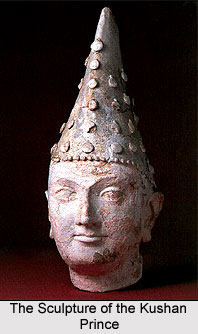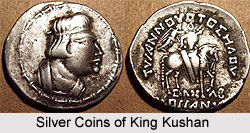 The age of the Kushanas marked an important epoch in the history of ancient India. The barbarian Yue-chis, the ancestors of the Kushana tribes, appeared in India with their nomadic habits. Gradually they learnt to live a settled life in Indian soil. They came in contact with the superior civilization of Indians and were ultimately assimilated by them. The coins, inscriptions and monuments of the age clearly represent this "cultural assimilation". Although the Kushanas were the borrowers of the older civilization of India, they improved it by introducing and inducing in it new vigour of cosmopolitanism.
The age of the Kushanas marked an important epoch in the history of ancient India. The barbarian Yue-chis, the ancestors of the Kushana tribes, appeared in India with their nomadic habits. Gradually they learnt to live a settled life in Indian soil. They came in contact with the superior civilization of Indians and were ultimately assimilated by them. The coins, inscriptions and monuments of the age clearly represent this "cultural assimilation". Although the Kushanas were the borrowers of the older civilization of India, they improved it by introducing and inducing in it new vigour of cosmopolitanism.
After the Mauryas, it was the Kushanas who initiated a political unity of India. The vast empire of the Kushanas embraced not only the entire tract of the northern and northwestern India, but also its boundary was extended outside India. A major portion of Central Asia was under the sway of the Kushanas. Northern India, which had suffered several ravages so long due to the invasion of the Indo-Greeks, Indo-Parthians and Indo-Scythians, after the arrival of the Kushanas, achieved a strong well-organised government. Peace established by the Kushanas in the consolidated North Indian Empire lasted for several generations.
The Kushanas induced multi-ethnicity by breaking the isolated character of Indian politics. Consolidating their supremacy in Northern India, the Kushanas established close political and commercial relationship with China, central Asia, and Roman Empire in Western Asia. Epigraphic and numismatics evidences of the Kushana Age, testifies the fact that the Indian merchants during the time of the Kushanas carried brisk trade with the countries of western and central Asia. Historians have opined that the first Kushana king Kadphises II had issued gold coins perhaps due to the influx of Roman gold in India.
The Indian Society was originally caste-ridden. Therefore the migration of several alien tribes like Scythians, Kushanas, Aviras, Maghas etc. led to a lot of turmoil within the ancient Indian society. Hence the caste-ridden Indian society found it difficult to assimilate and amalgamate those alien people in Indian society. The instant orthodox reaction was to shun the alien intruders and banish them out from the traditional folds of Indian society. "Manusanmhita" bore the picture of the horrified reaction of the orthodox in response to the infiltration of the barbarians and they held various injunctions in traditional Indian society, so they kept themselves away from the influence of the untouchable aliens. However the aliens, who came from outside were not baffled by this negative isolation of the Indians. The vibrant people who appeared as the mighty conquerors with military prowess made a forced entry into the Indian society by marrying Indian women or by embracing the Indian creeds like Bhagavatism, Buddhism and many more. As a result the alien tribes were soon Indianised and assimilated themselves with the Indian culture and society. At the same time they also imparted the Indians with their vigour, intellect and culture.
Historians have opined that the complete process of synthesis and assimilation of the alien culture with the Indian society was due to the fact that these virile warrior tribes did not bring with them any rich or matured civilization. Therefore the superior culture of Indian society absorbed them without much difficulty. Hence the mixed caste evolved within the traditional caste-ridden Indian society. Not only the way of life and culture of the aliens, the Indian way of life, customs, dress and literature were influenced by the aliens significantly. The impact of the Saka-Kushana culture on Indian life, dress and religion was prominently praiseworthy. The traditional dhoti chaddar and turban was replaced by the tight-fitted sewn garments. Kanishka`s headless statue in Mathura wearing choga and chapkan was a symbol of the new style of male dressing, brought by the Saka-Parthians in India. Indian aristocracy quickly adopted this dressing style. The coins of the Gupta age bears figures wearing the same dress. Not only the dressing style of the male, females were also influenced by the Saka Parthian and Kushana culture. The use of cholis or blouse to cover the upper part of the body came into use and the hairstyle of the upper class ladies changed. The use of ornaments, caskets and cosmetics like `kum-kum` and sandal paste were used by the aristocrat ladies of traditional Indian society.
Apart from the dressing habits, the alien culture also influenced the food habits, prevalent in the traditional Indian society. Food and the culinary preparation underwent a massive change and onion and garlic attained a special significance in Indian dishes. Beef, pork, chicken, which were prohibited before in the orthodox Indian Society, with the influence of the Saka-Parthians, were freely eaten in northwestern India. The "Manu Samhita" referred that though there was prohibition of eating such foods taken by the `Mlechchhas`, yet the people of northwestern India including Punjab and Sind were accustomed with the food habits of the Saka-Parthians. Periplus has referred to a special type of wine, which was imported from Syria and Persia to Taxila and Indian people were accustomed to that wine. With the influence of the Saka-Parthians and the Kushanas, drinking of liquor increased and women also became addicted towards it. This was testified by the Mathura and the Nagarjunakond Sculpture. Several fruits like pesta, nuts, peach, orange and figs, which were unknown to the Indians before, were imported from Central Asia and Iran.
Religious beliefs and ideas in India was also influenced by the Sakas and the Kushanas. Though worship of the mother goddess was known in India, yet it was popularised by the Sakas. Ujjaini and Saka-dvipa were the famous centres of worship of the mother goddess. According to the scholars, the Hindu cult of Uma and Durga riding on a lion`s back came into practice in the Indian society with the influence of the Kushana tribes. Aristocratic Indian people adopted the Devakula worship. The Kushana conception of Lakshmi was assimilated within the Indian concept of Gaja-Lakshmi. The concept of Kartikeya or the kumara cult, was the contribution of the Saka-Kushanas. The concept of the Sun God or the God of light was a perception of the Indo-Greeks, Kushanas and the Maghas. As a whole the entire religious and spiritual life of the Indians were influenced by the alien Saka-Kushanas.
The impact of the Saka-Kushanas on Indian art was immense. With the influence of the Saka Kushanas, the original Indian art received great impetus. Among the several branches of art and culture, the Indian ragas were influenced by the Saka-Kushana influence. This tribe added at least 3 new ragas, viz Avira, Saka and Kamboja and the mixed ragas of Saka, Saka-tilaka and Saka-Yoga. Dress of the Indian musicians also changed under the Saka-Parthian influence. They started to wear the tight-fitted sewn garments and pyjama, evident from the Bhumara sculpture. The trend of using "Vina" or harp with seven strings as the musical instrument was brought by the Indo-Greeks to ancient India. The great epic "Mahabharata" depicted the use of such a Vina.
 India made rapid progress in the fields of art and sculpture during the Kushana age. Four schools of art namely--Sarnath, Mathura, Amaravati and Gandhara developed during this period. However the most flourishing one was the Gandhara art. The trend of assimilating and harmonising the Buddhist and Hellenistic ideas with the native and original indigenous material or concept was considered the principal sculptural idiom of Gandhara art. The headless statue of Kanishka was the epitome of it. Various images of Buddha belonging to the Mathura school of art, which have been excavated till date, represents the blending of Hellenistic style with Indian concept. The Sarnath statue of Buddha has a special style with his right hand raised in assurance and the left hand fixed on his buttock. However all these represents the concept of the Mahayana creed. Mahayanism of Buddha, which flourished during that time, indicated Buddha`s spirit and energy rather than his inner spiritualism, which was found in the other Buddha images, apart from the Mathura school. Depiction of folk life was one of the chief features of the architectural style of that time. Depiction of wine parties with men and women engaged in revelry, statues of kings and aristocrats, were the sculptural features of the Kushana age in India. Apart from these schools, other branches of art were also not neglected. Since Kanishka was a patron of art and culture, every branch of art, architecture, language and literature flourished in India during his time.
India made rapid progress in the fields of art and sculpture during the Kushana age. Four schools of art namely--Sarnath, Mathura, Amaravati and Gandhara developed during this period. However the most flourishing one was the Gandhara art. The trend of assimilating and harmonising the Buddhist and Hellenistic ideas with the native and original indigenous material or concept was considered the principal sculptural idiom of Gandhara art. The headless statue of Kanishka was the epitome of it. Various images of Buddha belonging to the Mathura school of art, which have been excavated till date, represents the blending of Hellenistic style with Indian concept. The Sarnath statue of Buddha has a special style with his right hand raised in assurance and the left hand fixed on his buttock. However all these represents the concept of the Mahayana creed. Mahayanism of Buddha, which flourished during that time, indicated Buddha`s spirit and energy rather than his inner spiritualism, which was found in the other Buddha images, apart from the Mathura school. Depiction of folk life was one of the chief features of the architectural style of that time. Depiction of wine parties with men and women engaged in revelry, statues of kings and aristocrats, were the sculptural features of the Kushana age in India. Apart from these schools, other branches of art were also not neglected. Since Kanishka was a patron of art and culture, every branch of art, architecture, language and literature flourished in India during his time.
The `literary revival` was the chief achievement of the blending of Indian society with the alien culture. Sanskrit, which was at that time recognised as the language of the aristocratic Indians, was given a sheer patronage by the Kushana king Kanishka and he adopted it as the vehicle of Mahayanism. Kanishka was a patron of education and his court was adorned with a galaxy of scholars including intellectuals like Asvaghosa and Vasumitra. Literature during the Kushana period was categorised as secular and religious literature. Secular literature received a new impetus during that period, which paved the way for literary revival of the Gupta period. Though Sanskrit was the chief medium of literary expression, Pali was not altogether neglected. Pali was the language of the common people and this literature prospered even without court patronage.
Apart from influencing the art, architecture, religion and literature of India, the Kushanas initiated the Saka era, which had taken a permanent place in the Indian chronological system and introduced the gold currency, which continued till the Gupta Age. The Saka Kushanas, with their arrival, however changed the entire society and civilization of the Indian people.



















